 |
 |
 |
| |
Impact of protease mutations L33 F/I, V82A, I84V, and L90M on ritonavir-boosted protease inhibitor susceptibility
|
| |
| |
PJ Piliero1, N Parkin2, D Mayers1
1Boehringer Ingelheim Pharmaceuticals, Inc., Ridgefield, CT, USA; 2Monogram Biosciences, South San Francisco, CA, USA
Background
Tipranavir (TPV) is a non-peptidic protease inhibitor (PI) with a unique cross-resistance profile.
- The majority of multi-PI resistant HIV isolates remain susceptible to TPV.
TPV co-administered with ritonavir (TPV/r) is indicated for patients who are highly treatmentexperienced or are infected with HIV-1 strains resistant to multiple PIs.
Mutations at 4 key PI codons - 33, 82, 84, and 90 - have been associated with cross-resistance to PIs.
Phase II studies of TPV/r demonstrated that most isolates harboring 2 or fewer of these mutations maintained susceptibility to TPV and responded to combination therapy containing TPV/r [1].
This analysis was performed to evaluate the prevalence and impact of mutations at these key codons on susceptibility of available ritonavir-boosted protease inhibitors.
Methods
All routine patient testing samples received by Monogram Biosciences for drug resistance phenotype (Phenosense) and genotype (Geneseq) testing since January 2000 through February 2006 were analyzed. Isolates had to contain at least one drug-selected protease mutation: any non-wt amino acid at position 23, 24, 30, 32, 46, 47, 48, 50, 54, 82 (except I), 84, 88, 90 or L33I/F.
The L33F/I, V82A, I84V, and L90M mutations both individually and in combination were examined to evaluate the proportion of samples susceptible to different RTV-boosted PIs using recently updated clinical cut-offs. The percent susceptible to TPV and the other ritonavir-boosted PIs was compared using a Fisher's Exact test.
Resistance was defined by fold-change in IC50 of greater than the upper clinical cut-off:
- 8 (TPV)
- 55 (lopinavir, LPV)
- 11.5 (amprenavir, APV)
- 20 (atazanavir, ATV)
- 12 (saquinavir, SQV).
The number of samples for each PI varied depending on the time of drug approval. 9860 isolates with genotypic and phenotypic data for LPV, APV, and
SQV were available; 9007 for ATV, and 2272 for TPV. Darunavir was not studied as it was investigational at the time of this analysis.
Results
Prevalence of mutations
The prevalence of different key mutation groups (0-4) is seen in Table 1.
- Nearly 60% of isolates had 1 or 2 key mutations.
- Over one-third had 2 or 3 key mutations.
Impact on phenotypic susceptibility
In the absence of any key mutations, susceptibility (full or partial) is similar across the different PIs (Figure 1).
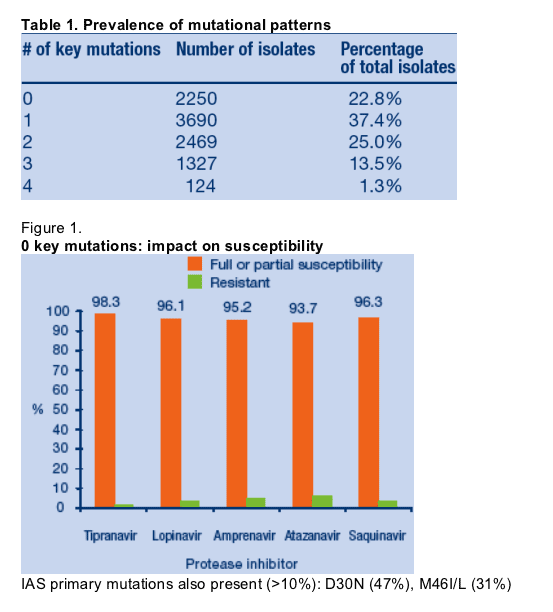
Increasing numbers of key mutations cause reduced susceptibility to all PIs (Figures 2-5):
-- In the presence of 2 or more mutations - at least half of the isolates were resistant to APV (50%), ATZ (58%) and SQV (70%).
-- In the presence of 3 or more mutations - at least 70% of the isolates were resistant to LPV (70%), APV (85%), ATZ (79%) and SQV (82%).
-- Only in the presence of 4 key mutations did the majority of isolates have resistance to TPV.
There is a differential impact of the key mutational patterns on susceptibility to the different PIs (Figures 2a-d, 3a-d, 4a-d):
-- The I84V mutation in the absence or presence of other key mutations had the greatest impact on susceptibility to PIs, including TPV.
-- The V82A mutation in the absence of other key mutations appeared to have no impact on susceptibility to TPV.
TPV susceptibility is least affected by any of the individual or combinations of key PI mutations.
Discussion
TPV is a recently approved PI with demonstrated efficacy in highly treatment experienced patients with resistance to more than one PI [2]. Mutations at more
than 2 key protease codons - 33, 82, 84, and 90 - have been shown in clinical trials to be associated with reduced susceptibility and response to TPV. Based on phase 2 and 3 clinical trials, a unique TPV mutation score has been derived taking into account 21 mutations at 16 codons which also have an impact on susceptibility and response [3]. Guidance exists in the APTIVUS package insert which correlates the number of key and TPV specific mutations with phenotypic fold change ranges (see Table 2).
The objective of this analysis was to evaluate the impact of the number and combinations of L33 F/I, V82A, I84V, and L90M on susceptibility to TPV and other ritonavir-boosted PIs. Consistent with previously presented data, the percentage of isolates susceptible to TPV was greater than the other PIs evaluated regardless of the number or combinations of these mutations. The presence of the I84V mutation either alone or in combination with other key mutations was associated with higher rates of resistance to TPV (but even higher rates of resistance to the other boosted PIs). The V82A which is selected by IDV, RTV, SQV, LPV, ATV had no impact on TPV susceptibility consistent with the fact that TPV selects for the V82L or V82T mutation. The L90M which is associated with resistance to all PIs also had very limited impact on TPV susceptibility.
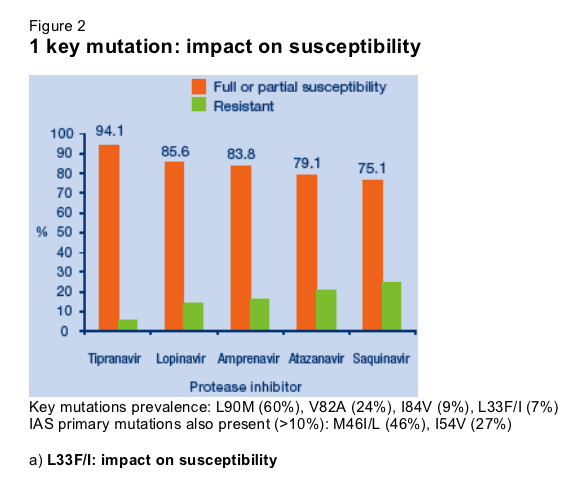
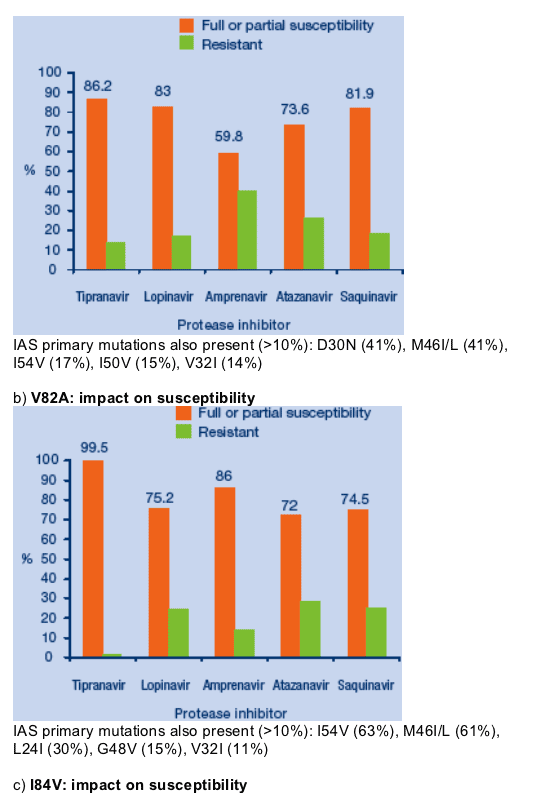
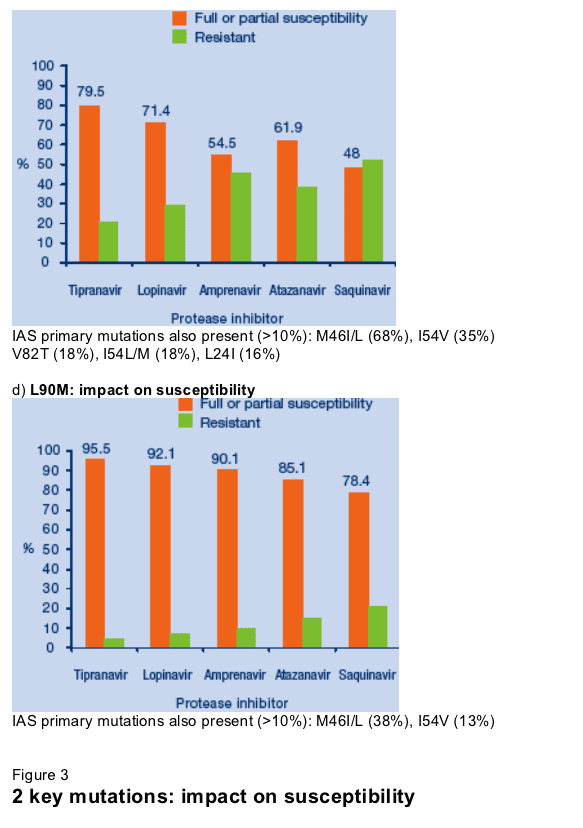


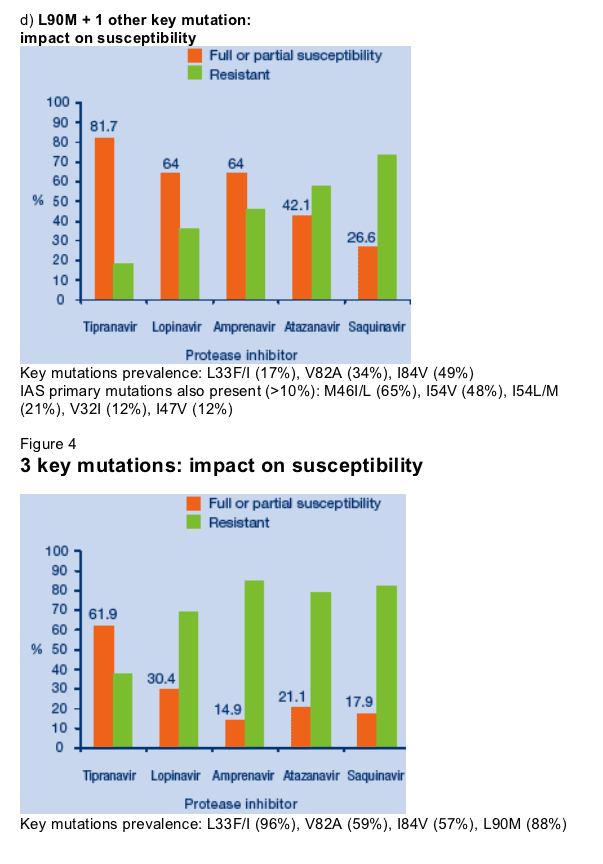
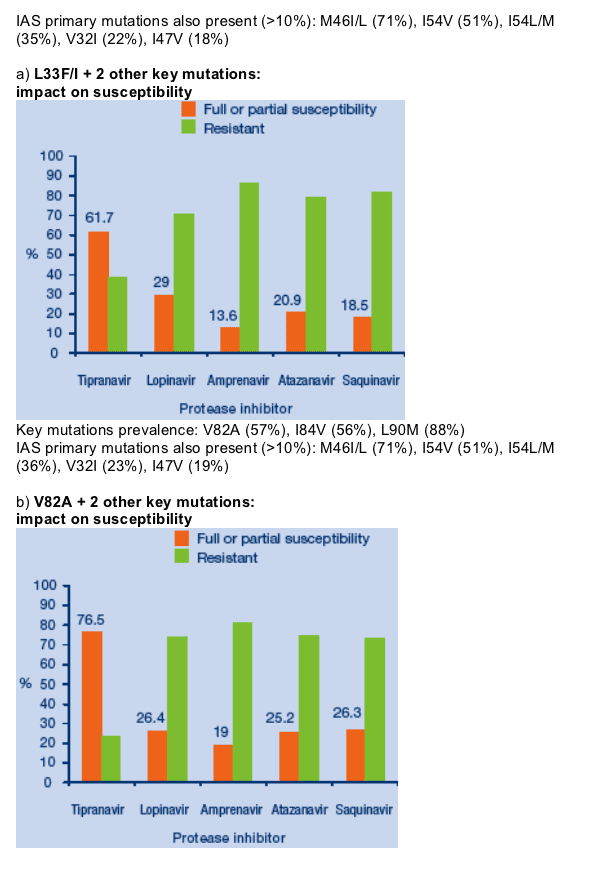
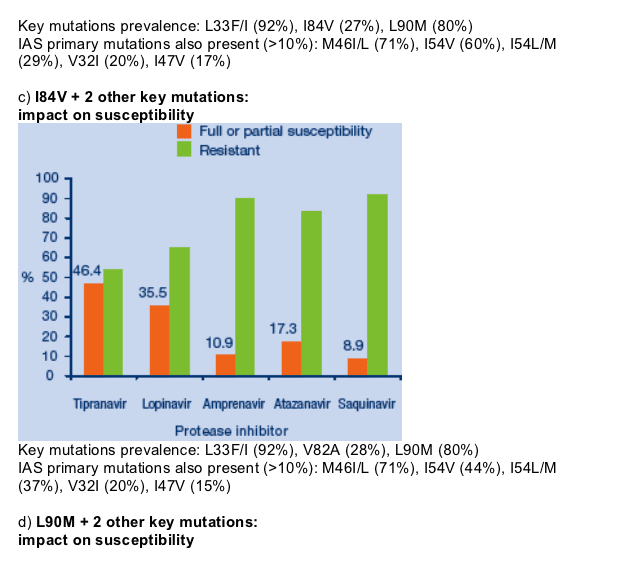
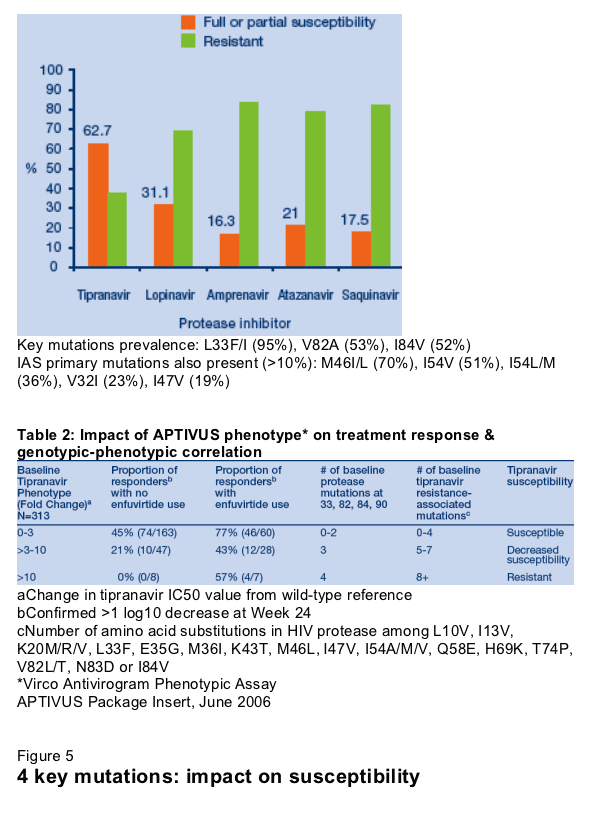

Potential limitations
Retrospective database analyses have a number of potential limitations:
- Proportions defined as susceptible or resistant are dependent on the clinical cut-offs utilized.
- Lower number of isolates were available for TPV vs. the other PI - potential for bias due to changes in resistance prevalence over time.
- The inclusion or exclusion of specific mutations. For example, in this analysis 82L and 82T were not considered and consequently the co-existence of either of these mutations with L33F/I, I84V, and L90M may have influenced the degree of susceptibility. Although this was a limitation, the prevalence of these mutations was low - 82L (0.5%) and 82T (4.0%).
- Analysis not controlled for the presence of other major PI mutations.
- Antiretroviral treatment history unknown.
AUTHOR CONCLUSIONS
Key PI mutations (L33F/I, V82A, I84V, L90M) have less of an impact on TPV susceptibility than the other RTV-boosted PIs evaluated.
For isolates containing 1, 2, or 3 key mutations, the percentage of isolates susceptible to TPV was significantly greater than for ritonavir-booster lopinavir, amprenavir, atazanavir, or saquinavir (p<0.0001); and for those isolates containing all 4 key mutations, the percentage of isolates susceptible to TPV was significantly greater than for ritonavir-booster amprenavir, atazanavir, or saquinavir (p<0.002).
The I84V mutation appears to contribute more than L33F/I, V82A, and L90M to susceptibility to all the PIs including TPV.
The V82A does not impact susceptibility to TPV at all, consistent with the fact the V82L and V82T are selected by TPV.
This analysis is consistent with the current guidance in the APTIVUS package insert and also provides additional detail on the differential impact of the various combinations of these key mutations.
Quantitative differences exist related to the specific combinations of the mutations present. Therefore phenotypic testing (if available) may provide additional guidance.
References
1. Cooper D, et al. Baseline phenotypic susceptibility to tipranavir/ritonavir is retained in isolates from patients with multiple protease inhibitor experience (BI 1182.52). Presented at the 10th Conference on Retroviruses and Opportunistic
Infections (CROI); February 10-14, 2003. Abstract 596.
2. Hicks CB, et al. Durable efficacy of tipranavir-ritonavir in combination with an optimised background regimen of antiretroviral drugs for treatment-experienced HIV-1-infected patients at 48 weeks in the RESIST studies: an analysis of combined data from two randomised open-label trials. Lancet 2006; 368: 466-75.
3. Baxter JD, et al. Genotypic changes in human immunodeficiency virus-1 protease associated with reduced susceptibility and virologic response to the protease inhibitor tiprananvir. J Virol 2006 (in press).
|
| |
|
 |
 |
|
|